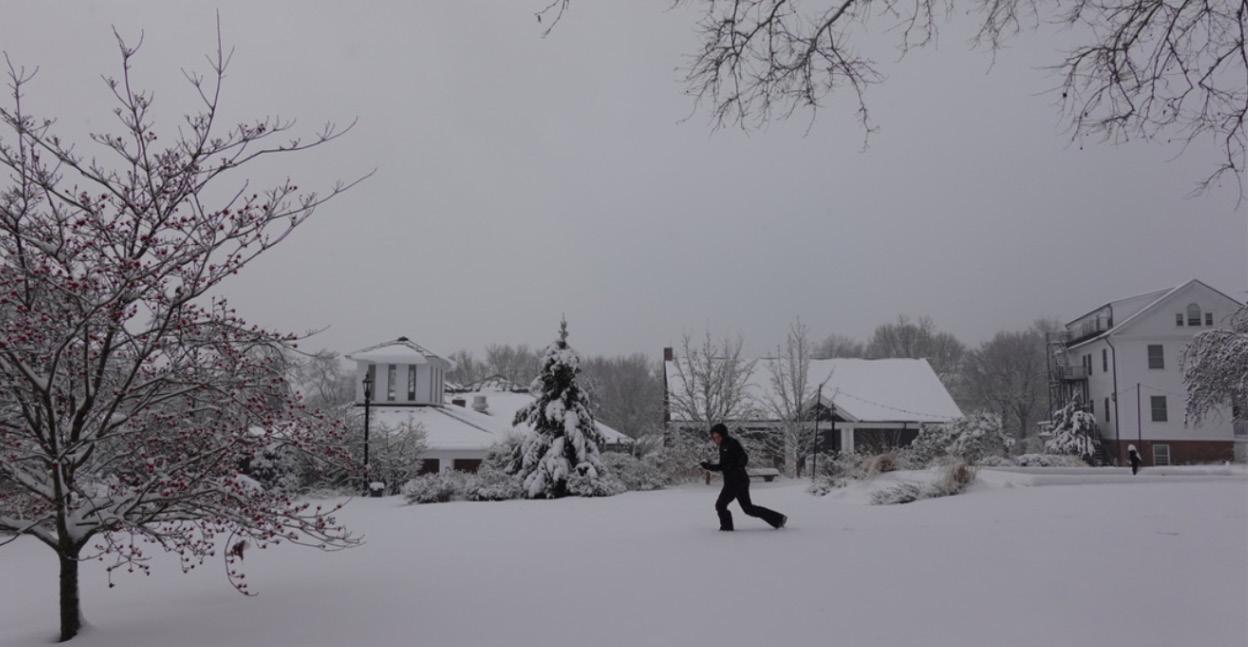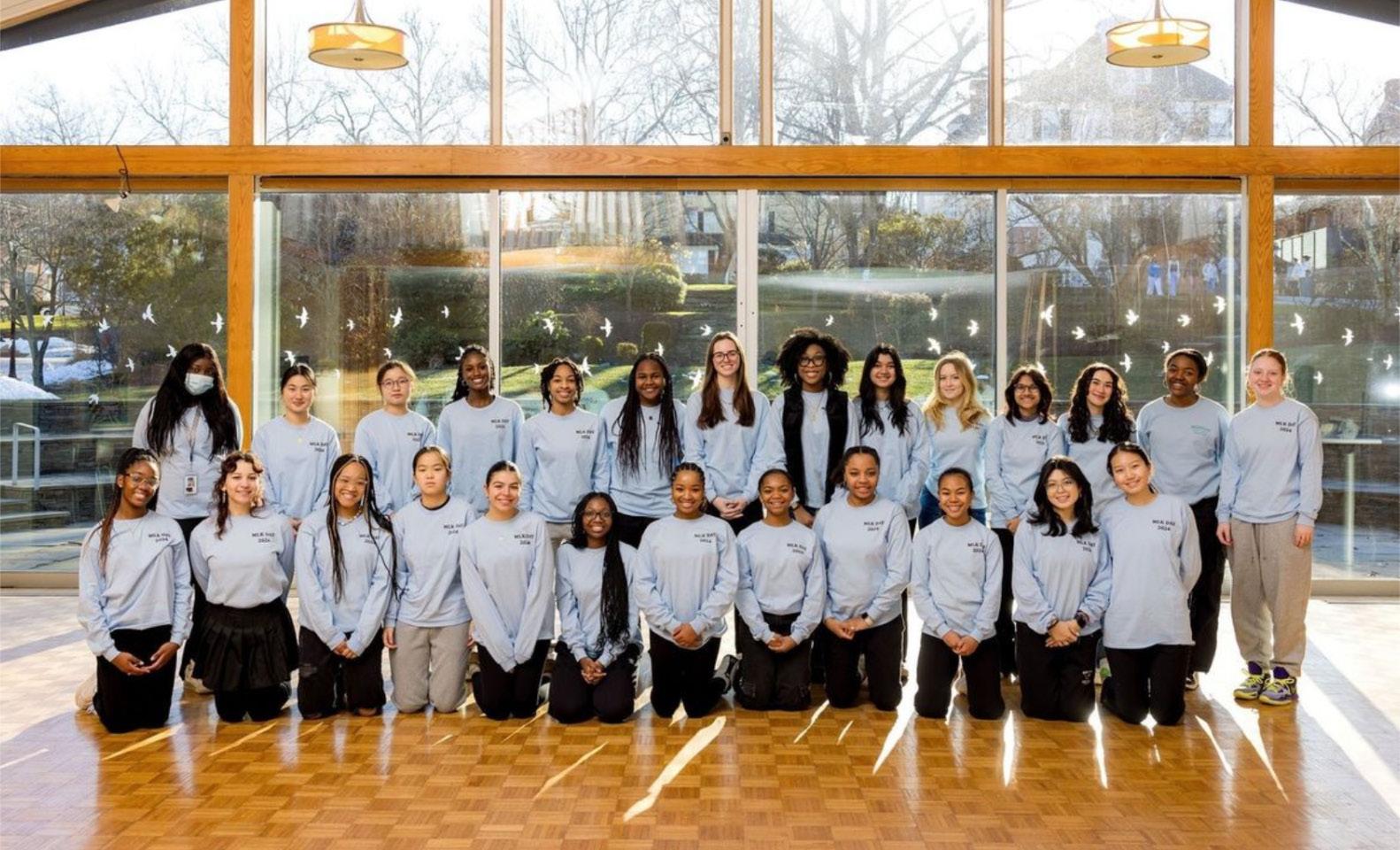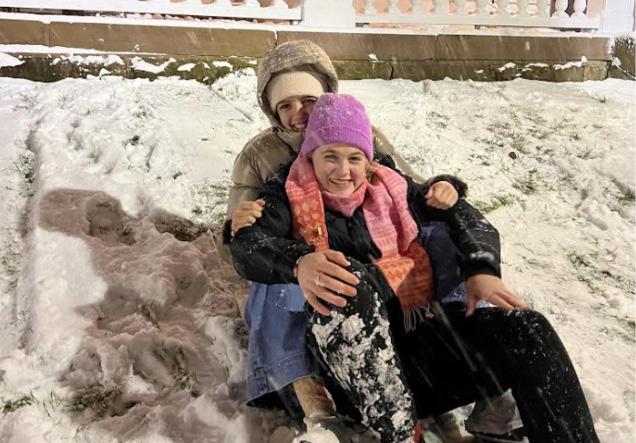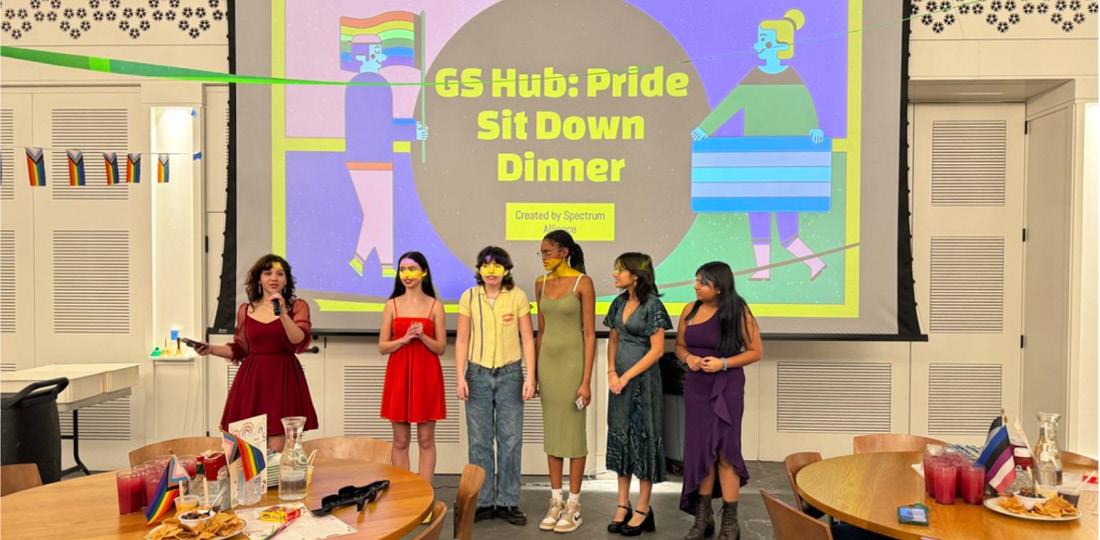
12 minute read
SALMAGUNDY
The Official Student Newpaper of Miss Porter’s School NEWS
Winter 2024
Inside The Bubble
Porter’s Celebrates Martin Luther King Jr. Day
By Rosa Yao ’25 Staff Writer
The 2024 Dr. Martin Luther King Jr. Day fell on Monday, January 15th. After months of planning, the Office of Equity and Inclusion and the Student MLK Planning Committee titled the community day “Black And…,” with themes emphasizing Dr. King’s mission to uplift the intersectionality, education, and endless beauty of Black identities. The day was kicked off in the Hacker Theatre, with an introduction by Katie Johnson ’27, a Journey Talk by Sophia Serile Yam ’27, a Poetry Performance by Yaya Blake ’24, and a dance performance by Princess Moore ’26, Genesis Lewis ’26, Summer-Zaire Bell ’26, Sophia Serile Yam ’27, Shannen Penn ’27, Katie Johnson ’27, and Ava Johnson ’27.
Throughout the day, student-led workshops delved into unique aspects of Black culture. For example, “Black And Behind the Scenes” explored Black filmmakers’ influence in the movie industry. “Black And Yum” displayed the importance of food, specifically cornbread, in bringing Black communities together. “Black And B.O.L.D. (Brave, Outreaching, Limitless, Diverse)” focused on the role of art in Black culture.
After the community day, Jamiah Bennett and ashley amoabeng, faculty members of the MLK Community Day Planning Community, shared their experience with the day as well as their appreciation to the student body and the Planning Committee.
Q: What are the visions of the MLK Community Day? -What is the purpose of having an MLK Day?
ashley: The theme of “Black And…” was curated by the student-led planning committee. The goal for MLK Community Day is to center MLK and provide flexibility in defining what it means to be capital B, “Black”. The inclusion of the ellipsis “Black And…” connects to MLK’s dream of having Black people being seen as more than just Black. The purpose of this community day is to celebrate and explore the multitude of intersectionality that is part of the Black experience.
Jamiah: There are two main purposes of having an MLK Community Day: one, to bring the community together; two, to honor the work of Dr. Martin Luther King Jr. We formalized our vision to honor those two purposes by having conversations with the student body [during which] we not only focused on his nonviolent pedagogy and practices, but also his emphasis on the intersectionality of Black identities.
Q: What is the most important aspect, in your opinion, about MLK Day? How did those aspects impact the MLK Day planning?
ashley: I think the most important part of the MLK community day is to come in with an open mind and an open heart. You have to be willing to learn and grow, have tough conversations, and cherish the moments of joy of Black culture. This day is about letting go of ignorance and prejudice to ashley: The MLK Planning Committee truly put in a lot of hard work and effort in making sure this day was a success. From creating the schedule, planning the opening and conclusion, and creating the lunch menu with FLIK, students had a hand in each part of the decision-making process. I want to give a shoutout to all the members of the planning committee, as well as the members of OEI to see this day into fruition. Thank you to the members of the community for being engaged and having thoughtful discussions in the workshops and the advisory. I hope you enjoy this day as much as I did.

Jamiah: I’ve heard that Black people are sharing our stories, we are just not being listened to. So I think one of the most important aspects of the MLK Community Day is highlighting and uplifting voices of Black people who often are marginalized for a variety of reasons. The Community Day provides an intentional dedicated time for people to listen to Black voices and the experiences that come with that identity.
Q: What do you think of the student body and the MLK committee’s performance that day?
Jamiah: I was proud to witness their vision come to life. I’ve received a lot of positive feedback from students across the campus about their experiences and the day. Many have thought the student works were uplifting and empowering the joy of Black identity. Typically, hosting and engaging in activities and events like this could be heavy and intense. However, the student performances for our MLK Community Day this year showcased the positive and exciting aspects of Black identity and experience. I think they did a great job of focusing on the positives.
Day Students Say More Snow Days Needed to Ensure Safety
By Beatrice Kibler’26 & Annabelle Horst ’26 Staff Writer & Inside the Bubble News Editor
Snow is a beloved winter delight by the Porter’s community. Students take pictures around the snow-covered campus, throw snowballs around with their friends, sled at the Hillstead, and even make snow cones. However, the excitement of the snow often dies down with the realization that there would not be a snow day. There has been a snow day, and on many occasions, a snow day may have been permissible. Snow days benefit Porter’s by giving a needed day off as well as ensuring the safety of many valued community members. When school is still held in icy conditions, the priorities of the administration are questioned.
The lack of snow days impacted all students and staff, specifically those who do not live on campus. Claire Orfitelli ‘26, the sophomore day student representative, highlighted the various struggles of being a day student during the snow storms. Orfitelli stated that “the lack of snow days creates an unfair disadvantage to day students,” as driving in these snowy and icy conditions can be dangerous. Orfitelli also said that younger students may be unable to come to school due to their “lack of transportation, especially if a parent refuses to drive.”
This disadvantage is also felt by students who drive. Day student Shreya Sudarsan ‘24 drives to school every day. “I actually almost died once,” she said, recounting a time when she had to make a sudden stop to avoid hitting a pedestrian on her way to school. Her car hit a pile of snow, pushing her into oncoming traffic. Though she was able to avoid a collision, the incident could have ended a lot differently, she said.
Sudarsan said her fellow day students sometimes travel an hour each day to get to campus. If day students decide to stay home, she said, there is a lack of support in these absences. For example, students may have to miss important lessons or assignments and in turn, double their workload. Sudarsan stated that “day students have to choose between potentially risking their life or risk missing an important lesson.”
Michael Bergin, chief financial and operating officer of Porter’s, received backlash from students regarding the lack of snow days. Bergin is known for being passionate about student safety, so many students were surprised that on Jan. 16, a day when many students felt unsafe coming to school, classes were still held. Bergin explained the variety of factors considered when deciding whether to call a snow day. “We review the weather forecast in detail with particular attention to the timing of any inclement weather,” he said. “If a storm is coming through late morning into the evening, that is different from one that starts at 2 a.m. and runs through the morning rush hour. There is also a big difference between snow and sleet or ice.”

He said that he and Liz Schmitt, chief enrollment and student affairs officer, also consult with Rich Higley, director of facilities, as well as the Farmington Department of Public Works before making a decision.
“We are always concerned about the safety and welfare of all of our students,’ Bergin said. “For day students, we encourage all families to exercise caution and make their own decisions about the safety of travel to and from school based on their specific circumstances. When it is snowy out, our ground crew works extra hard to ensure the paths are salted and snow
GS HUB Pride Sit-Down Dinner Celebrates Diversity and Inclusion
By Sofia Garza ’26 Staff Writer

pride celebration due to graduation always being during the start of Pride Month.
To plan this dinner, the Gender and Sexuality student leaders worked closely with FLIK to decide what would best represent pride at the dinner. According to Shravya Sudarshan, a head of the GS Hub, many of their ideas could not be displayed in just one dinner, so in collaboration with FLIK, colorful and rainbow food was brought out all week to celebrate pride, including Fruit Loops and rainbow bagels The planning process for the sit-down included meetings with the leaders of the GS Hub to brainstorm the best way to celebrate pride with the student body.
Students made a presentation at the beginning of the sit-down to spread awareness of the history of the pride movement and some personal stories. The food included chicken nuggets, blue raspberry lemonade, tri-colored mac and cheese, rainbow pound cake, and colorful vegetables.
On Jan. 23, the Gender and Sexuality Hub organized its first pride sitdown dinner including a week celebrating pride at Porter’s.
Finn De Vries, a student leader of the Gender and Sexuality Hub, said this sit-down was significant because Porter’s has never had an all-school
De Vries said they hoped that events that celebrate pride can continue and will include more than just meetings. Sudarshan expressed similar feelings, noting that while discussions surrounding identity are confined to meetings, awareness was spread to the whole community with the sitdown. Both heads said they want to make students in the community feel included and supported with their identities, and this event was an important step in making this goal a reality.
Leaders Urge Students to Make Space for Difficult Conversations
By Lilia Coe ’27 and Goodluck Ogbonna ’27 Staff Writers
In a world full of diversity, different opinions, and ideas, people sometimes struggle to co-exist, creating a never-ending battle to prove whether their ideas are more right than others. At Porter’s, students come from many parts of the world with varying perspectives and beliefs that can sometimes clash. At times, community members say they notice an underlying feeling of division on campus.
Some say this tension has been especially apparent since the Israel-Hamas war began last fall, prompting administrators to look for ways to encourage respectful dialogue and learning. Tim Quinn, chief academic officer and dean of faculty, recently announced plans to host conversations about the war in his home.
Salmagundy reporters sent a Google form survey to the entire school to find out how students and faculty viewed the community’s ability to tackle difficult issues.
Of the 19 who responded, some reported feeling uncomfortable expressing their opinions because they feared backlash for not supporting the majority’s opinion. Others said they did feel comfortable expressing themselves and some answered no when asked if people felt divided by political issues on campus. Still, some community members wonder if they feel united because they don’t really discuss pressing issues.
One faculty responder said they hesitate to publicly take a position on global issues, afraid that it will be a dividing factor between them and their students. They acknowledged “cancel culture” on campus and said that when they experienced a “microaggression,” they attempted to understand the perspective of the person who made the offensive comment.
But tensions around the Israel-Hamas conflict have been particularly fraught at times. A group of Porter’s students planned a walk-out in December to call for a ceasefire. The school canceled the event because of outside threats. Since the incident, one student said she “feels surprised that people are so one-sided” and is “glad that spaces are being set up to talk about it.”
Another student said “Innocent people are dying however you look at it. … People are oppressed on both sides, and we should acknowledge it.” Quinn has created a space for students and staff at his home where people can have structured conversations and learn about the Israel-Hamas war. He encourages students to arrive with an open mind and questions.
“As a community, it’s OK to be divided on issues that we view differently,” Quinn said. “It allows us to learn and grow as a community. But we should be united in the search for truth, understanding, and justice even if we disagree on how to get there.” Quinn added that he views censorship as harmful. “I acknowledge that there are hateful ideas,” he said. “I do not condone spreading them but I support free speech. Free speech is a tool used by those who have been oppressed and other marginalized communities. Without free speech, social change cannot happen, and once we start restricting speech we are moving toward fascism and authoritarianism. It is important to listen to each other even if we don’t agree.”
Susan Martell Jenkin, chief equity and inclusion officer, said the school is an “intentionally diverse community” and acknowledged that some topics of disagreement, such as the current events in Israel and Gaza, may increase tensions around campus. She attributed the increase in self-censorship among students to cancel culture.
“I wish students felt more empowered to host conversations, forums, or Q&As together,” Martell Jenkin said. “It is so important for young people to practice holding space for conversations on pressing issues so that they can gain the skills necessary to have these conversations when they leave MPS.”
For a community to grow, Quinn and Martell Jenkin say, it must be able to listen in times of difference. This is why they want to create safe spaces where people can freely discuss uncomfortable topics, and why they believe it’s important to understand what the other side is protesting for.





